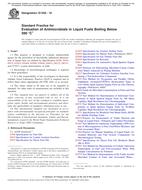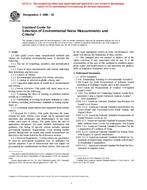1.1 This guide briefly describes the state-of-the-art of radiation monitors for detecting special nuclear material (SNM) (see 3.1.11) in order to establish the context in which to write performance standards for the monitors. This guide extracts information from technical documentation to provide information for selecting, calibrating, testing, and operating such radiation monitors when they are used for the control and protection of SNM. This guide offers an unobtrusive means of searching pedestrians, packages, and motor vehicles for concealed SNM as one part of a nuclear material control or security plan for nuclear materials. The radiation monitors can provide an efficient, sensitive, and reliable means of detecting the theft of small quantities of SNM while maintaining a low likelihood of nuisance alarms.
1.2 Dependable operation of SNM radiation monitors rests on selecting appropriate monitors for the task, operating them in a hospitable environment, and conducting an effective program to test, calibrate, and maintain them. Effective operation also requires training in the use of monitors for the security inspectors who attend them. Training is particularly important for hand-held monitoring where the inspector plays an important role in the search by scanning the instrument over pedestrians and packages or throughout a motor vehicle.
1.3 SNM radiation monitors are commercially available in three forms:
1.3.1 Small Hand-Held Monitors- These monitors may be used by an inspector to manually search pedestrians and vehicles that stop for inspection.
1.3.2 Automatic Pedestrian Monitors -These monitors are doorway or portal monitors that search pedestrians in motion as they pass between radiation detectors, or wait-in monitoring booths that make extended measurements to search pedestrians while they stop to obtain exit clearance.
1.3.3 Automatic Vehicle Monitors -These monitors are portals that monitor vehicles as they pass between radiation detectors, or vehicle monitoring stations that make extended measurements to search vehicles while they stop to obtain exit clearance.
1.4 Guidance for applying SNM monitors is available as Atomic Energy Commission/Nuclear Regulatory Commission (AEC/NRC) regulatory guides, AEC/ERDA/DOE performance standards, and more recently as handbooks and applications guides published by national laboratories under DOE sponsorship. This broad information base covering the pertinent physics, engineering practice, and equipment available for monitoring has had no automatic mechanism for periodic review and revision. This ASTM series of guides and standards will consolidate the information in a form that is reexamined and updated on a fixed schedule.
1.5 Up-to-date information on monitoring allows both nuclear facilities and regulatory agencies to be aware of the current range of monitoring alternatives. Up-to-date information also allows manufacturers to be aware of the current goals of facilities and regulators, for example, to obtain particular sensitivities at a low nuisance alarm rate with instrumentation that is dependable and easy to maintain.
1.6 This guide updates and expands the scope of NRC regulatory guides and AEC/ERDA/DOE SNM monitor performance standards using the listed publications as a technical basis.
1.7 The values stated in SI units are to be regarded as the standard.
1.8 This standard may involve hazardous materials, operations, and equipment. This standard does not purport to address all of the safety problems associated with its use. It is the responsibility of the user of this standard to establish appropriate safety and health practices and determine the applicability of regulatory limitations prior to use.
Product Details
- Published:
- 06/10/1999
- Number of Pages:
- 9
- File Size:
- 1 file , 430 KB


